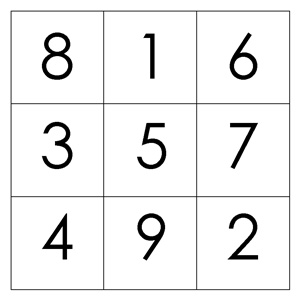The fun facts about numbers that you didn’t realise you’ve always wanted to know…
13 – THIRTEEN
The unluckiest number on the planet? Friday 13th, buildings without floor 13, airplanes without row 13, sports teams with no number 13… It’s certainly a long-list, but unluckiest? The Far East may have something to say about that. In many Asian languages the number 4 sounds like ‘death’ – a little scarier I’d say – which is why for example there’s no gate 4 or gate 44 at Inchon Airport in Seoul, South Korea. Thirteen does, however, have an entire psychological condition named after it: triskaidekaphobia – the fear of the number 13. Apparently the condition costs the US economy millions of dollars each year from absenteeism and cancellations.
So why is the number 13 unlucky then? It perhaps makes sense to fear the number 4 if it sounds like ‘death’, but thirteen sounds more like ‘curtain’ if you say it over and over again (or at least it does to me) and I think it’s fair to say curtains are possibly one of the least scary things on the planet. Unless of course there’s a masked murdered hiding behind them…
There is no scientific evidence behind the fear of the number 13, but there are a few sort-of-possibly-maybe believable explanations. Some of my favourites include: there were 13 people at the Last Supper, traditionally there were 13 steps to the gallows and 13 is roughly the age children start to misbehave as they hit puberty. It’d be easier to believe it if just sounded like something a little scarier than ‘curtain’…
14 – FOURTEEN
A very popular number in the Bible, whether its 14 rains, 14 lambs, 14 plagues, 14 rams, 14 cubits or my personal favourite 14 wives, the Holy Book loves a reference to the number 14. These days it’s mostly associated with love thanks to good old St. Valentine. He was a Roman saint from back in the 3rd century and we don’t know much else about him. True to sucking-the-fun-out-everything form, the Catholic Church even removed him from the General Roman Calendar in 1969, though they at least do continue to recognise him as a saint. In my head he was some kind of Casanova meets Gene Simmons womaniser – though I dread to think what that would mean he would have looked like…


15 – FIFTEEN
Fifteen seems to have more fun facts associated with it than other double digit numbers, perhaps owing to its position slap back in the middle of 10 and 20. It is particularly popular amongst the more philosophical members of society and can be found in all of the following quotes:
“After 15 minutes nobody looks at a rainbow” Johann Wolfgang von Goethe, Playwright
“I have drunk since I was 15 and nothing gives me more pleasure” Ernest Hemingway
“In the future everyone will be world-famous for 15 minutes” Andy Warhol
“A revolution only lasts 15 years, a period which coincides with the effectiveness of a generation” Jose Ortega y Gasset, Philosopher
“15 men on a dead man’s chest, yo-ho-ho and a bottle of rum” Jack Sparrow (amongst others)
Fifteen is also a big deal in the world of maths, specifically for magic squares. A magic square is a table of numbers where each row, column and diagonal add up to the same total. The simplest example is the 3×3 magic square with each row, column and the two diagonals all adding up to 15. There are a few different ways that you can arrange the numbers 1-9 to make such a magic square, anyone want to hazard a guess as to how many exactly?

Sorry it was a trick, there are only 8 (assuming you thought I meant 15). There is only one pattern that will allow all of the rows, columns and diagonals to add up to 15 and then you make the other 7 by reflecting and rotating the original. Here’s how it works:
- To start with put 5 in the centre.
- Next put the even numbers in the four corners. You have four choices for the first corner (2, 4, 6 and 8) and once selected this then fixes the opposite corner in order to make the diagonal add up to 15.
- This leaves two even numbers for each of the two remaining corners. Once you select one then the other is filled automatically.
- Finally, the odd numbers are placed in the four remaining spaces to make each row and column add up to 15. There is only one way to do this.
Looking back, we see that there are four choices initially for the first corner (step 2), and then two more for the third corner (step 3) which gives a total of 4 x 2 = 8 choices altogether. You can also take the example square shown above and then rotate it 4 times by 90 degrees, as well as doing a reflection of each one in the diagonal to get the 8 different possibilities. Give it a try and see how you get on!
And just to leave you all with a sobering thought, 15 seconds is believed to be the average time that an employer will spend looking at an applicant’s CV… now where’s that rum?
You can find all of the funbers articles here and all of the episodes from the series with BBC Radio Cambridgeshire and BBC Radio Oxford here.

[…] thirteen was the unluckiest number in the world? (If you don’t you should go back and read the previous funbers article – it’s great) Well, seventeen wants a word. In Italy, the number 17 is feared because in Roman […]
LikeLike
[…] to know’ about a different number every week. From the beauty of the ‘Golden Ratio’ to the world’s unluckiest number (is it really 13?) via the murderous tale of ‘Pythagoras’ Constant’, Funbers is a source of […]
LikeLike